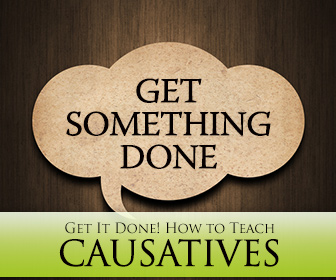You feel you need a little pick me up and head on over to the hair salon to get a super chic haircut.
The following day, you walk into your classroom – what will your students say? Nine times out of ten they’ll say, “Teacher, you cut your hair!” And you know that’s not true because you never touched the scissors. You did not cut your own hair; you had it done at the hair salon. Ah… there comes a time when we all must teach this distinction, and the use of causatives. And here’s how:

How to Teach Causatives:
-
1
Set the Context
First, make sure students understand when we use causatives. Ask them questions like:
T: Do you fix your own car?
S: No, I don’t.
T: Who does that for you?
S: The mechanic does.T: Do you cut your own hair?
S: No, I don’t.
T: Who does that for you?/Who cuts your hair?
S: The hairdresser does. -
2
Introduce the Causatives with have
Tell students: You don’t fix your own car. You have the mechanic fix your car. You don’t cut your own hair. You have the hairdresser cut your hair.
Make sure they understand the main idea: You cause the action by having another person do it. You either can’t, don’t know how or don’t want to do it yourself. They should also understand the distinction between having someone do something as a “service” vs. as a “favor”. For example, I wouldn’t say I had my sister cut my hair, but rather that I asked her if she could do me the favor and trim it for me – she’s under no obligation to say yes, and she doesn’t have to take orders from me.
-
3
Point out the Structure
This first type of causative is formed like this:
Subject + have (in any tense) + person + verb in base form I + have (had/will have) + the mechanic + fix (my car). -
4
Practice – Sentence Transformation
Flashcards, illustrations or images with jobs and occupations are very useful for practice. Show a magazine cutout or picture of someone repairing a computer. Say: The technician repaired my computer. Students should reply by using the causative: You had the technician repair your computer. Go through as many examples as needed and make sure to use different tenses.
You may also want to have students ask each other questions: Do you have the mechanic check the oil or cut your hair? Do you have the dentist check your teeth or your eyes? Etc…
-
5
Introduce the Passive Form of Causatives
Similar to the previous is the passive form of causatives: have/get something done. If you’re teaching this separately or on another occasion, don’t forget Step 1 and set the context. Then say: You have the mechanic repair your car. Or you have your car repaired (by the mechanic).
Make sure that students see that as in any passive form, you focus less on the person doing the action (in this case, the mechanic, and more on the action itself). The important thing is that if you say that you “have your car repaired”, you are emphasizing the fact that you are paying for this service because you can’t/don’t want to do it yourself.
-
6
Point out the Structure
The passive form of the causative is formed like this:
Subject + have (in any tense) + object/thing + past participle of verb I + have (had/will have) + my car + repaired -
7
Practice – Locations
Name a location and have students say what they have done there:
T: At the dentist’s office
S: I have my teeth checked at the dentist’s office.
T: At the dry cleaner’s
S: I have my suits cleaned at the dry cleaner’s.
T: At the beauty salon.
S: I have my hair washed/cut/dried/styled.Give students the opportunity to ask each other questions: Where do you usually have your hair cut? How often do you have your eyes checked? How often do you have the oil changed?
-
8
Introduce the Option of Using “Get”
Tell students that in the passive form they can replace “have” with “get” and also say they “get something done”. For extended practice, have students summarize the things they get done once a year vs. once a month or more often: I get my teeth and eyes checked once a year. I get my clothes washed once a week. I get my hair cut every three months.
-
9
Consolidation Activity – Busy, Busy, Busy…
Tell students they must plan a party. Or road trip. Anything that requires a great deal of preparation and errands. They must compile a list of things they must get done and who will do it for them. It should look like this:

Road Trip:
I will take the car to the mechanic’s and have the oil and the tires checked. I might have the oil changed. I will also have the engine and the brakes checked. Then, I will have my travel agent book my hotel room. One day before my trip, I will have the car washed. Etc…
Another option would be to have them write a story of how someone prepared for an event, like a party: First, Emma had the baker make a special cake. Then, she had her secretary email the invitations. Etc…
You can look for pictures in magazines and cut them out, or you can have your class do that. You can make a comic strip or have your class draw one. You can read a timeless classic or have your class write one up. Isn’t it great when you can get so many things done?
P.S. If you enjoyed this article, please help spread it by clicking one of those sharing buttons below. And if you are interested in more, you should follow our Facebook page where we share more about creative, non-boring ways to teach English.







